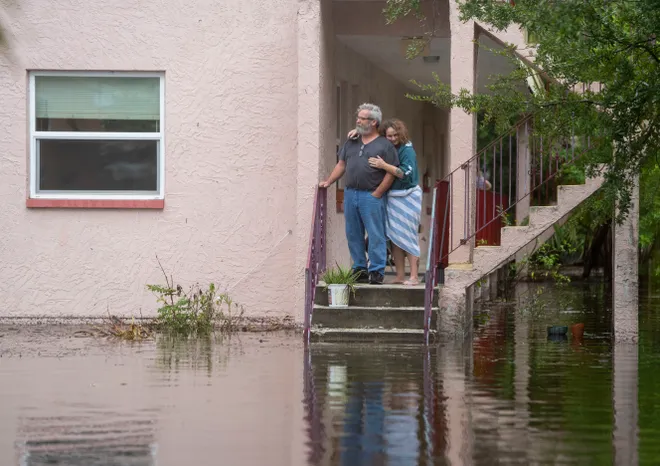The National Weather Service stated in a preliminary study that when Hurricane Idalia made landfall on the Florida coast on August 30, the Category 3 hurricane brought a surge of seawater up to 12 feet above normally dry terrain.

In Crystal River, Florida, on August 30, 2023, in the aftermath of Hurricane Idalia, a guy can be seen riding his bicycle through the flooded streets. (Source: USA Today)
The Rising of Seawater due to Hurricane Idalia
The category 3 hurricane winds momentarily hit 130 mph before making landfall in Keaton Beach with 125 mph winds. Category 3 hurricane Idalia pushed water levels 7-12 feet higher along more than 33 miles of coast to the north and south of the center, according to a weather service survey team. Idalia was the first Category 3 storm to hit the thinly populated coast in decades, destroying Gulf-front villages and damaging a stretch of houses, businesses, and woods between the Gulf and southern Georgia. Moody’s RMS, a Moody’s Analytics firm and international risk modeling company, projected privately insured losses from Idalia to be between $3 billion and $5 billion.
According to the report, the maximum surge values were reported from Dekle Beach in Taylor County south to Horseshoe Beach in Dixie County. The devastation could have been far greater, but a critical aspect favored the region. Idalia arrived at low tide. “Had the storm made landfall 6 hours later, around the time of high tide, peak water level values could have been 3-4 feet higher.”
READ ALSO: New England Coast Spared from the Hurricane Lee
Destruction of Water Surge Due to Category 3 Hurricane Idalia
According to the weather service, the destructive water surge damaged countless structures along the coast, as well as homes and businesses many miles inland. Lower values of up to 6 feet above the normally dry ground were discovered south of Horseshoe Beach, near the Suwannee settlement. The surge may have rivaled the ‘Storm of the Century’ in terms of magnitude. During the high-water mark survey, several locals who lived in the area during the famed “Storm of the Century” in March 1993 spoke with the weather service crew.
According to the weather service, all of the locals interviewed from Keaton Beach to Horseshoe Beach said Idalia’s water levels “rivaled or exceeded” the water levels in 1993. The storm surge was much farther inland from Horseshoe Beach than it did during the 1993 storm, according to Dixie County Emergency Management. However, the weather service stated that “it is still too early to state that definitively.” It intends to compare survey results from the two events and make a decision later.
The weather agency claimed that live video from Steinhatchee helped confirm the flood levels. Data from a regional water management agency gauge 2.5 miles upstream from the mouth of the Steinhatchee River was also used by the survey team. This gauge indicated a river height of around 8.03 feet, nearly a foot higher than during Hurricane Hermine. In one hour, the gauge reported a six-foot climb. Further south, the Tampa Bay weather service reported that the water level in Cedar Key, where Idalia arrived at low tide, was 6.89 feet above dry ground. Water levels reached 3.2 feet in Fort Myers, Florida, more than 240 miles to the south.
READ ALSO: Summer 2023: Hottest Summer Recorded

















































